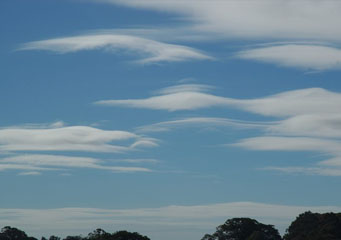
Above: Stratocumulus Lenticularis
Names of Clouds
Clouds form when the water evaporates and collects high up in the atmosphere of Earth. Clouds are from the bodies of water like oceans, seas, lakes and rivers, among other bodies of water. This process is also called evapotranspiration, or the transfer of moist from the land surface to the atmosphere. As the vapor continues to rise and get into higher levels of the atmosphere, the clouds change in density, shape, color and water content. Once the water condenses, the rain will start to fall and the clouds will disappear, only to form again in an endless process called the water cycle.
Etymology of clouds
The clouds are named according to their appearances, water content and location in the atmosphere. The etymology of the clouds is mostly scientific, which means if we try tracing the origins of the names of clouds, they will have Latin roots. In nephrology, which is the study of cloud physics, the names are given much importance by scientists. Although they may look very similar to a typical person, each cloud type and subtype is very different from the rest. Therefore, each of them needs a name.
Tropospheric clouds
Tropospheric clouds are the most common. These clouds are divided into three primary categories according to their physical appearances, which names all have Latin roots. The cirriform category of clouds typically forms filaments. The two other categories, the cumuliform and the stratiform, are either sheet-like or heaped and rolled.
Keep in mind that the appearance of the clouds are a major distinction and is cause enough to change the cloud names of the subtypes. In addition, the cumuliform or cumulous clouds can have many subtypes, such as the cumulus lenticularis and floccus. The combination of two types of clouds can also create another name. For instance, the combination of cirrus and cumulous cloud types will create a cirrocumulus cloud. The cirrocumulus has subtypes as well.
Genus types of clouds
There are about ten genus types of clouds, which names are all derived from cross-classifying the three categories that are mentioned above. These categories are then defined into four families, which are varied according to altitude range:
- Low
- Middle
- High
- Moderate vertical
A moderate vertical cloud is one that has an end on a higher level, and the other on a lower level. These are often big clouds. They are called the stratiform, cirriform and so on. Through combining the genus of the cumuliform clouds and the altitude family name, you can come up with the proper name for a cloud. For instance, a high stratiform and cumuliform will both have the prefix cirro, although the combined form would be cirrostratus.
Sub-families and naming conventions
There are other sub-families for clouds, too. These will depend, of course, on which root family they belong. The cumulus congestus, for instance, as well as the cumulonimbus have names that are derived in this way.
There are other naming conventions for clouds that are just as important. The point is, all clouds are different from one another. Basically, naming and differentiating the cloud types is necessary in fields like meteorology.
